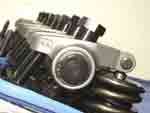
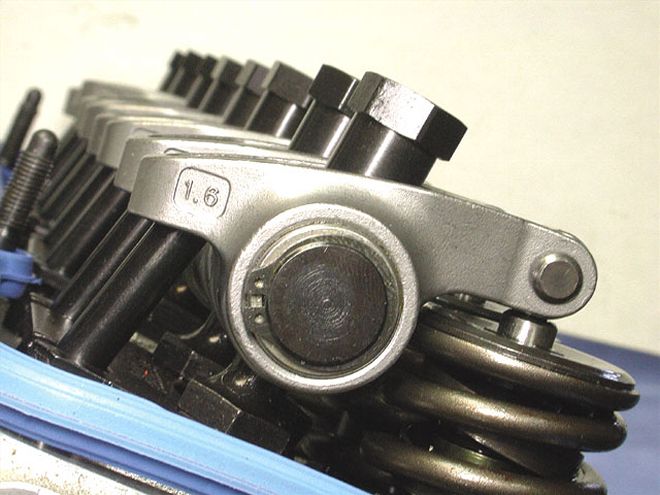
At some point in your high-performance life, you've probably owned or known about an engine that just seemed to run great. You know, the kind that made amazing power and that couldn't be hurt, no matter how much you beat on it. One of the reasons for that is a well-executed valvetrain. As little as 10 years ago, valvetrains were not nearly as sophisticated, and aluminum roller rockers and stiff valvesprings were expensive and intended only for race engines. Now, the world is overflowing with roller-rocker street engines, often with small-base-circle cams and valvesprings that could support a railroad flatcar.
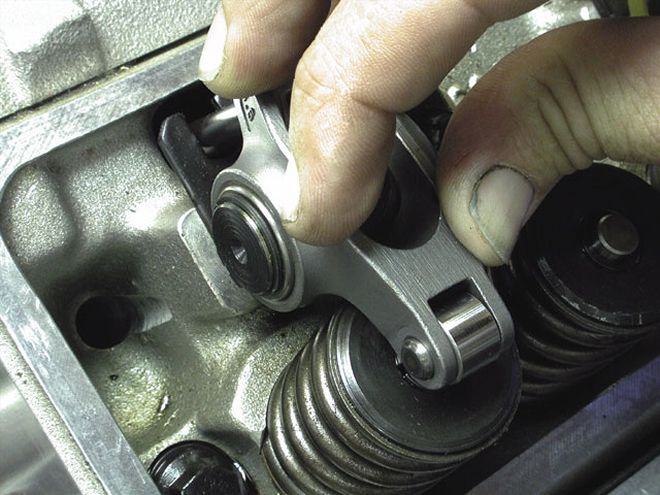 We began our exercise by removing our small-block Chevy valve cover and bumping the engine over until the first rocker arm was on the base circle of the cam. We removed the rocker and colored the tip with a marking pen. We then slipped the rocker back over the stud and used the roller tip to make a witness mark on the valve-stem tip.
We began our exercise by removing our small-block Chevy valve cover and bumping the engine over until the first rocker arm was on the base circle of the cam. We removed the rocker and colored the tip with a marking pen. We then slipped the rocker back over the stud and used the roller tip to make a witness mark on the valve-stem tip.
Out of the tremendous selection of camshafts, rocker arms, pushrods, and valve installed heights, the most overlooked must be the pushrod length. Granted, getting this correct probably won't ring the bell on the Richter horsepower scale, but it will make a difference in how long your valvetrain can take a beating and keep on ticking. If you're going to spend serious money on quality parts, it's a good idea to make sure they all work well together. One way to keep your valvetrain happy is to make sure the pushrod length is correct.
Geometry Lesson
All pushrod engines that pivot a rocker arm on a stud determine the location of the rocker-arm tip relative to the valve tip with pushrod length. The small-block Chevy, along with many other production engines, originally came equipped with stamped-steel rocker arms. These rockers used a very wide rocker tip with a very gentle radius that was extremely forgiving when it came to pushrod length. The pushrod length could be short or long and the broad rocker-arm tip would accommodate it.
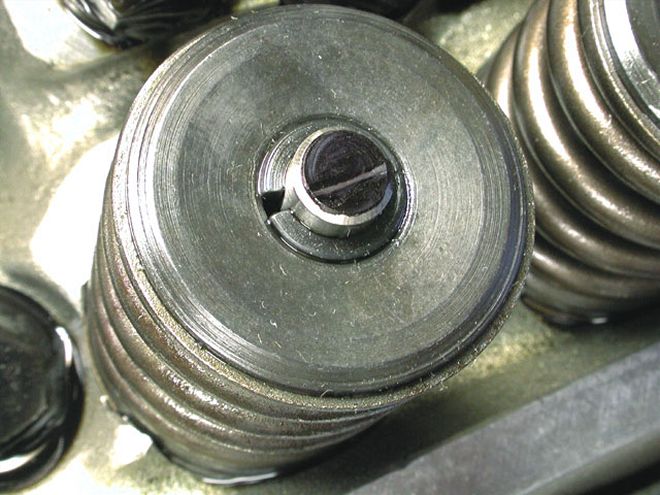 Note how the roller tip has made a witness mark just slightly outboard of the middle of the valve-stem tip. This pushrod is too long.
Note how the roller tip has made a witness mark just slightly outboard of the middle of the valve-stem tip. This pushrod is too long.
But then car crafters began shelving those flimsy stamped rockers for more race-oriented roller rockers. When you look at a roller-rocker arm, they all come with a roller tip that is the contact point to the valve-stem tip. The roller tip concentrates the entire load (working against valvespring pressure) into a very tiny contact patch. Given this small area, it becomes very important to position the roller tip properly over the valve stem. If the pushrod is not the correct length, the rocker tip will not be properly located near the middle of the valve-stem tip at half lift.
Tip Travel
Before we get into establishing pushrod length, we should address how the rocker tip travels across the tip of the valve. You might think the tip remains in the same place throughout the entire lift curve. But as it creates lift, the rocker arm travels in an arc that sends the rocker tip across the valve-stem tip. Amazingly, the rocker-arm tip moves quite a bit, especially if the pushrod length is not correct. Proper pushrod length tends to minimize the amount of rocker-tip travel across the valve tip.
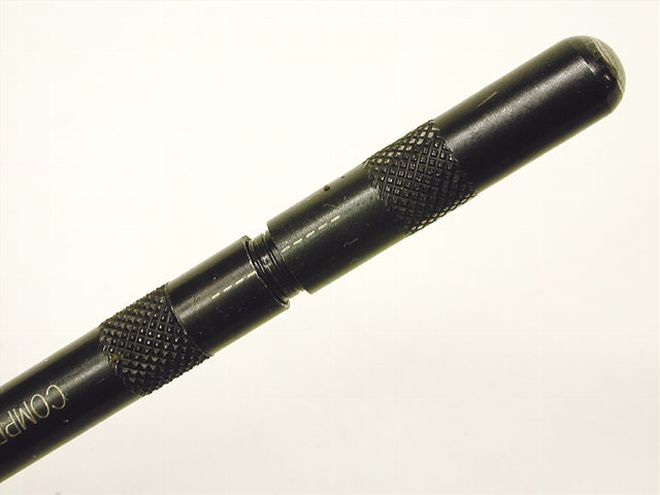 To establish exactly how much shorter to make our new pushrod, we used this Comp Cams adjustable pushrod. For every turn of the threads on the pushrod, it adds 0.050 inch to the overall length. Think of it as a pushrod micrometer.
To establish exactly how much shorter to make our new pushrod, we used this Comp Cams adjustable pushrod. For every turn of the threads on the pushrod, it adds 0.050 inch to the overall length. Think of it as a pushrod micrometer.
It's worth discussing the fact that the rocker tip is actually quite busy across the valve-stem tip. Even with proper pushrod length, the rocker tip starts from the inboard side of the rocker. As lift begins, the rocker tip moves toward the center of the valve tip, approaching the middle of the valve at approximately half of maximum valve lift. As lift continues, the rocker tip moves past the valve tip's center toward the outboard edge of the valve stem at max lift. Then as the valve begins to close, the rocker tip retraces its movement back to where it began. In essence, the rocker tip sweeps across the valve-stem tip and then returns. This is what the rocker tip does with proper pushrod length. With either too-short or too-long pushrods, the roller tip starts in the wrong position and travels much farther. This can lead to all kinds of dangerous situations, all of which can also create valvetrain problems.
It's worth mentioning that this improper pushrod length can also cause increased valveguide wear, even in engines with relatively low mileage. This is especially true with higher rocker-arm ratios due to the additional side load imparted on the valve-stem tip. Any time the rocker arm pushes laterally across the top of the valve-stem tip, a certain amount of lateral leverage is generated against the guide. The only way to minimize this is to reduce the amount of leverage on the valve from the rocker arm. The easiest way to do that is to establish the proper pushrod length!
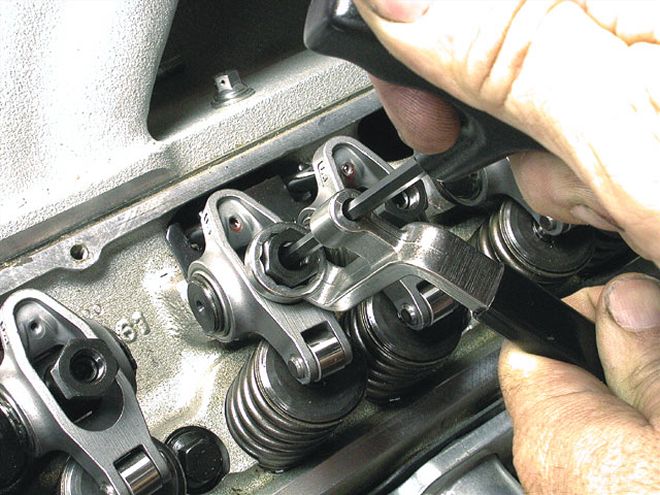 Changing to a set of only slightly longer 8.050-inch Comp Cams pushrods moved the witness mark more toward the middle, improving the rocker geometry and reducing the side load on the valve stem. This also reduced the amount of travel across the face of the valve-stem tip.
Changing to a set of only slightly longer 8.050-inch Comp Cams pushrods moved the witness mark more toward the middle, improving the rocker geometry and reducing the side load on the valve stem. This also reduced the amount of travel across the face of the valve-stem tip.
Adjustable Pushrods
Here's where we get down to the how-to details. All you really need to check for proper pushrod length is a black felt-tip marker and a couple handtools. Yank a valve cover and rotate the engine over until the rocker arm of your choice is on the base circle of the lobe. Loosen and remove the rocker arm. Clean the top of the valve-stem tip and then paint the tip with the black marker. Then place the rocker back over the stud and rub the roller tip to create a witness mark on the valve-stem tip. Now remove the rocker arm and look for the mark.
If the pushrod length is correct, the witness mark should be located on the inboard third of the valve-stem tip. If the witness mark is too close to the intake side of the valve-stem tip, the pushrod is too short. If the witness mark is in the middle or toward the exhaust side of the valve-stem tip, then the pushrod is too long.
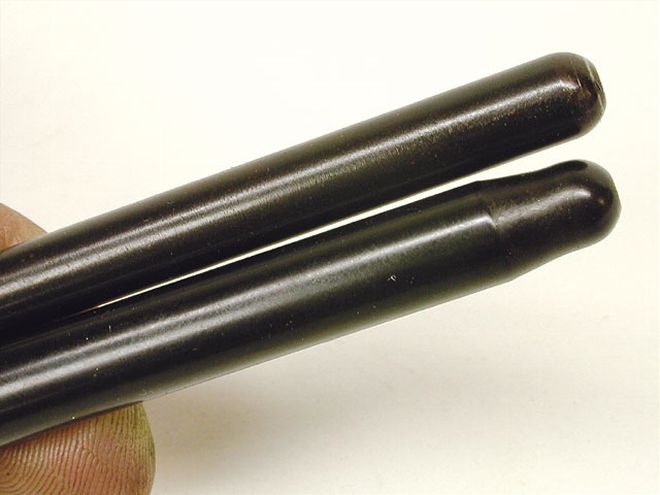 Everyone talks about lightweight valvetrain components, but one area where a heavier component might be an advantage would be with the pushrods. Most small-blocks run a 5/16-inch pushrod. The larger 3/8-inch rod is much stiffer.
Everyone talks about lightweight valvetrain components, but one area where a heavier component might be an advantage would be with the pushrods. Most small-blocks run a 5/16-inch pushrod. The larger 3/8-inch rod is much stiffer.
Let's assume you check several rockers and all your pushrods are too short. The best way to establish the proper length is to use an adjustable checking pushrod. Crane, Isky, and others offer adjustable pushrods, but the slickest tool is made by Comp Cams. This tool screws apart just like the others, but rather than having to measure the actual length of the pushrod, the Comp Cams tool reads out the length on the side of the pushrod just like a micrometer. Comp sells individual checking pushrods, or you can purchase an entire set intended for those who build many different types of pushrod engines. With this tool, you merely adjust the length of the pushrod until the witness mark is on the inboard third of the valve-stem tip. Then count the number of turns the pushrod is lengthened and you have the proper pushrod length, since each turn is worth 0.050 inch. It's best to wait until you've mocked up the engine for the last time to check for pushrod length.This way, a change to installed height or a cam change won't require a pushrod change.
Setting proper pushrod length isn't going to make an extra 100 hp, or make your engine last forever. But, it is one more step in the process of building a durable, efficient, high-performance engine that will make great power without the usual parts carnage.
Parts List
Component; Company; PN
 The simplest way to reset the lash on any four-stroke engine is to work on one cylinder at a time. Bump the engine over until the exhaust valve just starts to open. This places the intake on the base circle. Now set the intake.
The simplest way to reset the lash on any four-stroke engine is to work on one cylinder at a time. Bump the engine over until the exhaust valve just starts to open. This places the intake on the base circle. Now set the intake.
Master pushrod checking kit; Comp; 7705
SB Chevy checking pushrod; Comp; 7703-1
Adjustable pushrod, 5.7-8.7; Crane; 99726
The Variables
These are just some of the variables that will affect pushrod length.
* Block deck height
* Rocker ratio
* Mechanical versus hydraulic cam
* Small-base-circle cams
* Different intake and exhaust base circles
* Valve installed height
* Lash caps
* Variations between manufacturers' rocker designs
* Rocker-stud runout